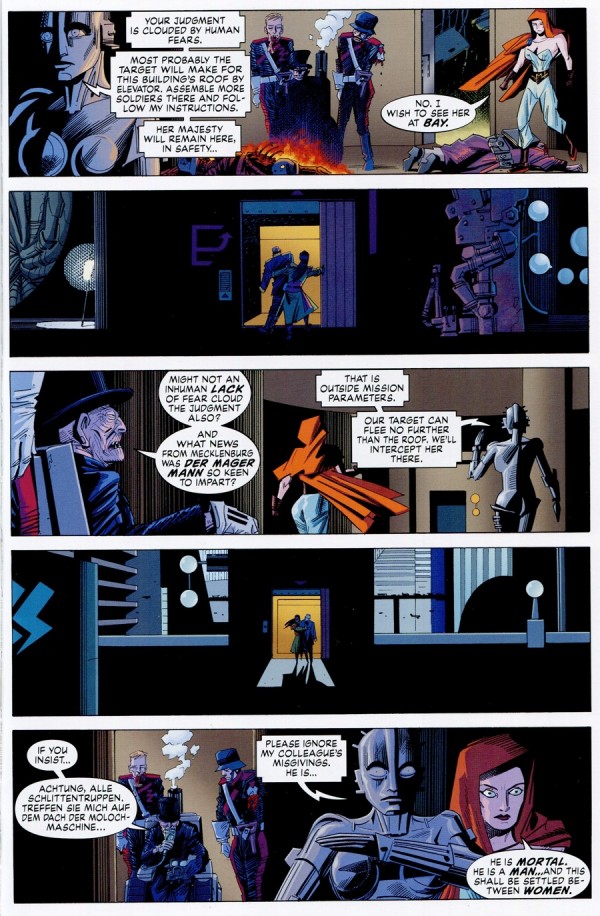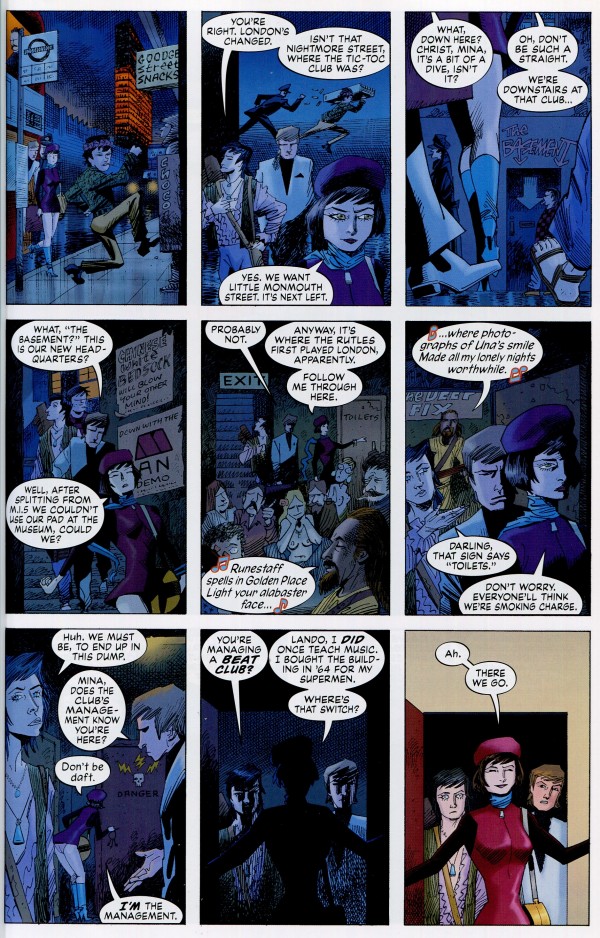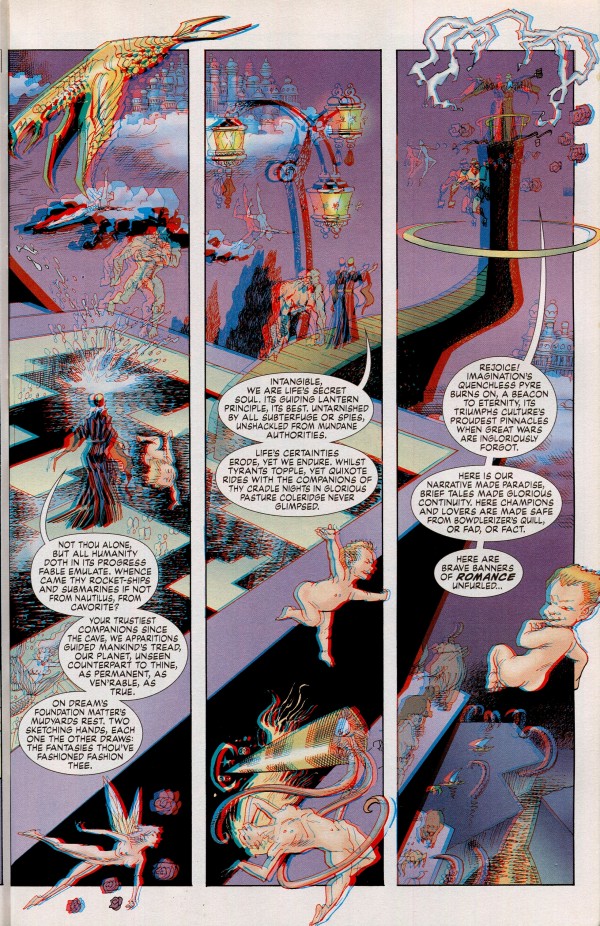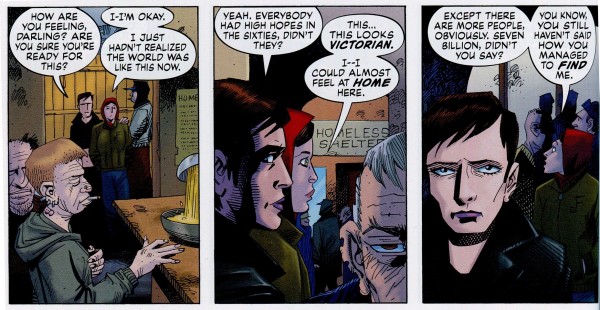What We’re Reading: League of Extraordinary Gentlemen, Part 2

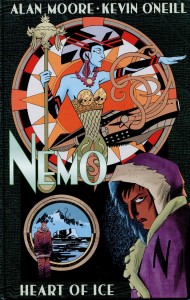 League of Extraordinary Gentlemen: Century 1910, Nemo: Heart of Ice, Nemo: Roses of Berlin by Alan Moore & Kevin O’Neill (Top Shelf, 2009-2014)
League of Extraordinary Gentlemen: Century 1910, Nemo: Heart of Ice, Nemo: Roses of Berlin by Alan Moore & Kevin O’Neill (Top Shelf, 2009-2014)
[For part one of this review, see here.]
The body of fiction that Moore and O’Neill draw from to build the world of the League (and maybe this is obvious) is work that is available to them. This generally means that the works are produced in or translated into English and at least somewhat available for purchase in England. In practice, this becomes a lot of books by white people from England, France, America, and Germany.
Whether this is on purpose or not, it reflects the way that, for Europe and North America, white people have defined the rest of the world. The stories we consume, whether they be books or television, historical or modern, were created in a white idiom. Education and news are curated by people who grew up in this idiom. Even if we aren’t aware of it, white people have used art and science and religion and everything else to define and reinforce a view of the world that is beneficial to them. (For a deeper yet accessible explanation, please check out the links under the “Topical” heading on the Medieval POC FAQ. Then read the whole blog.)
This is damaging in our own world, and it’s no better in League. The exoticized views of those places outside of Europe and America are made real, and the voices of the people that live there are practically silenced due to the lack of influence of those authors. How can this be addressed?
In the first part of this review, I mentioned that Wilhelmina Murray, by living through her trauma and bettering herself in spite of it, offers resistance to the white men that are trying to own the world. The idea of personal betterment as a form of resistance, though, is sort of a white, neoliberal idea of resistance. “I can’t affect the world, but I can at least affect myself and those around me” is really easy to say when you have access to education and when the system, at least in part, is working for you. Men inflict intense mistreatment on Murray due solely to her gender and sexuality, but things would be worse for her if she weren’t a white British music teacher.
This is where the two volumes of Nemo come in. They aren’t about Prince Dakkar, the Captain Nemo of 20,000 Leagues Under the Sea. They’re about Janni Dakkar, his daughter. (For clarity’s sake, I’ll be referring to the father as Dakkar and to the daughter as Janni.)
Janni is first mentioned in Black Dossier as the reason that Prince Dakkar leaves Lincoln Island, the home he retired to after the events of the Verne novels. Dakkar is persistently portrayed as a stubborn misogynist, and it’s revealed that he joined the League in volume one because he couldn’t stand to stay on his island home with only a daughter to carry his line.
Janni eventually leaves the island in anger, unwilling to live under her father’s orders. This is our first real introduction to Janni, in act one of Century, and it isn’t long before she becomes a victim of the masculine culture of 1910 London. Unlike Murray, whose class and race offer some standing in that society, Janni finds herself a job as a maid at a tavern and brothel, where she is eventually assaulted and raped by the male patrons.
In trying to escape the tyranny of her father, she finds only more violent males. With no way to navigate within the system—no hope of justice from the people around her—she takes the only recourse she can see. When her father’s advisor comes with news of Dakkar’s death, Janni becomes the leader of the pirate empire her father has established, and with the power of the Nautilus and its crew, she bombards the homes along the docks.
Heart of Ice has Janni taking the same trek through Lovecraftian Antarctica that her father did, navigating it better, all while being chased by a thinly veiled version of Tom Swift, boy adventurer. Where Tom has everything going for him—riches, education, technology—it’s Janni who triumphs.
(Also of note is that the taser is actually a TASER: Tom A. Swift’s Electric Rifle. In besting Swift, Janni has bested a symbol of police power.)
Swift was chasing Janni on the orders of one Ayesha, an immortal queen whose jewels were stolen by Janni and her pirates. Roses of Berlin, set 20 years later, continues the feud. Ayesha has Janni’s daughter and son-in-law possibly killed or captured by Adenoid Hynkel and his Nazis. Janni and her lover fight through the mechanized German metropolis to save them or, if they aren’t able to be saved, to take vengeance on Hynkel and his minions.
In the end, Janni must face Ayesha alongside Maria, the “gynoid” robot created by Dr. Rotwang to serve the new German metropolis. In a callback to the end of Century, only women are left.
In contrast to Century, though, the women here are an immortal white woman whose power was taken forcefully from Africa and China and a man-created replica of a woman (also named Parody and Delusion in the original novel) who serves an empire of white supremacists. Here, simply being a woman isn’t enough to make one good; Ayesha and Maria lack the kind of empathy that Murray wielded throughout the other books.
And what of Janni? She’s been shown unapologetically looting and killing for about 30 years. Does she possess those traits that made Murray the protagonist of the rest of the series?
Janni’s empathy extends especially to those who have been discarded by the world, those who have been colonized, ruled over, exploited, and forgotten. While Murray might occasionally use violence against the “properly” defined villains who threatened her life, Janni sees the problems lie at a societal level instead of a personal one. Whole civilizations are villains, and they have been stealing and murdering far longer than she’s been alive. These problems are still extant in our society. As recently as this year, Brittney Cooper wrote “In Defense of Black Rage” for Salon. She said, “Violence is the effect, not the cause of the concentrated poverty that locks that many poor people up together with no conceivable way out and no productive way to channel their rage at having an existence that is adjacent to the American dream.” Janni is not overreacting to the world around her; she’s using the only tools left available to her.
So much of race and racism was invented alongside “modern” science and philosophy in the century just before League begins. While Murray’s tale shows a group of people slowly realizing the systematized violence and exploitation that exists around them, Janni, as shown in Nemo, is born into that exploitation. Is she justified in taking up arms against her oppressors? And does this more nuanced portrayal of a person of color somehow “make up” for the racial stereotype of the Galley-Wag in the other League books?
What We’re Reading: League of Extraordinary Gentlemen, Part 1

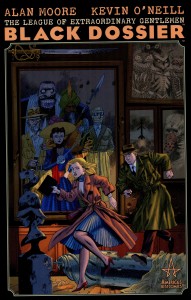 League of Extraordinary Gentlemen (Volumes 1 & 2, The Black Dossier, Century) by Alan Moore & Kevin O’Neill (ABC/Top Shelf, 1999-2009)
League of Extraordinary Gentlemen (Volumes 1 & 2, The Black Dossier, Century) by Alan Moore & Kevin O’Neill (ABC/Top Shelf, 1999-2009)
I set out to reread all of Alan Moore & Kevin O’Neill’s League of Extraordinary Gentlemen. It comes in at just under 1,000 pages of comics, prose, maps, and paraphernalia published between 1999 and 2014. It’s a lot of comics, second only to Moore’s time writing Swamp Thing and much longer than Watchmen, V for Vendetta, or From Hell. It was an ill-advised goal, and because of that, this review will be split into two parts.
The main conceit of the series is that almost all of the fiction ever created exists in a single world. The early volumes, taken singly, seem to be simple adventure stories; Moore and O’Neill build a team of adventurers (Wilhelmina Harker/Murray, the Invisible Man, Dr. Jekyll/Mr. Hyde, Captain Nemo, and Allan Quatermain) for the British government, and they go out and stop threats to the Empire. By smashing the volumes together and ignoring what I see as the false climaxes of each book, I’ve come to believe that League is an attempt to teach empathy, fight against masculine and colonial narratives, and save the best bits of story for the future. I would say it mostly succeeds, but its failures, when they occur, are somewhat drastic.
The conceit I mentioned—all of the fiction existing together—means that Moore and O’Neill can pack panels with references, both visual and verbal, to the sources of the main characters and other fictions contemporary to the League:
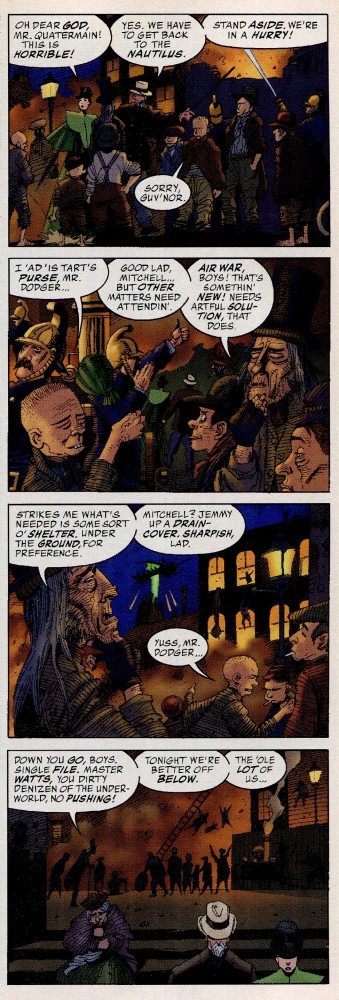
That’s Dickens’ Artful Dodger leading ancestors of the Watts and Mitchell families from The EastEnders while referencing the future Blitz of WWII.
This method of world-building is often seen as “fanwank” in certain circles; that is, it’s a way off—a private wink and nod to anyone following along or a prideful testament to the creators’ knowledge.
The references, though, are artfully amassed in such a way that they don’t impede the story. The antagonists of The Black Dossier, for instance, are a bunch of selfish, cruel spies working for British intelligence. Their names, their goals, their personalities, and their relationships are clearly established. Is there an extra layer to their words and interactions if you know all the ’50s espionage fiction they come from? Yes, definitely. That entire genre is a gap in my reading history, though, and I find the entire story perfectly compelling without that outside knowledge. The references don’t seem to be hiding any weaknesses in the storytelling.
So if it’s not for showing off, why build a world in such a way? It’s my opinion that the density of background references serve the subtly didactic goal of the whole series: teaching people how to be humane.
In a typical piece of fiction, crowds are faceless things that can serve a number of functions: setting detail, Greek-style chorus, or symbolic. They are usually distinctive from both protagonists and antagonists, who both regularly distance themselves from crowds for various reasons. In League, though, as soon as a background character is shown to be, say, the Artful Dodger, a reader might stop to consider each crowd member. What book are they from? How did they get from the events of their source story to the events of League?
This results in a sort of forced consideration, and even if a reader doesn’t want to figure out who each face in the crowd is, the implication of hundreds of stories, each with a different protagonist is there on the page.
If League is at least partly about empathy, where else can it be found? Many of the characters possess a distinct lack of empathy in one way or another: Nemo is a misogynist, Hyde is a murderer and racist, and Quatermain is so worried about his own life that he has to be talked into any unselfish acts. Wilhelmina Murray, however, the only character to appear in and survive all the non-Nemo books, is an understanding and compassionate person.
Murray, counted amongst the monsters of the team due to her victimization at the hands of Dracula and subsequent divorce from Jonathan Harker, is shown to be repeatedly empathetic to the sufferings of others, and she seems to be one of the few characters driven by a moral compass defined by keeping others from suffering. She’s appalled by the decision to bomb the Chinese-settled neighborhood of Limehouse in volume one, and in volume two, she shudders at the idea of using an engineered disease against invaders from Mars. She’s the only one who seeks to understand the murderous Mr. Hyde, which angers him to no end.
Indeed, as most of the League dies around her and the remainder, granted immortality, trudges on, Murray is the only one to adapt to the changing times as she meanders from 1899 to 2009. In the ‘50s presented in The Black Dossier, while Quatermain is terrified of robots and spaceflight, Murray is delighted. In 1969, while Quatermain and Orlando make fun Murray’s dress and how she has peppered her speech with contemporary slang.
This adaptability is seen as a weakness; Murray has failed to somehow stay true to herself. However, the characters that stay to true to some sort of externally defined morality, whether it’s the uptight superiority of the Victorian era or the “do what thou wilt” detachment that Orlando has developed since his birth in ancient Greece, end up looking foolish or, well, being killed. These philosophies all depend on an Other—for the Victorian men, it’s anyone who isn’t a white male, and for Orlando, it’s anyone who isn’t a laissez-faire immortal. Murray seeks to understand the Other and incorporate herself with them (and them with her).
Her power of understanding is often linked with the act of reading, which shows that empathy can be developed by both narrative fiction alongside fact. In volume one, she’s the only character who has read the stories of Nemo, Quatermain, and Sherlock Holmes. She’s the only one that reads all the files that the government assembles for the team, which always grants her an advanced understanding of the selfish goals of the men they work under.
This idea of the saving power of stories is further exemplified in the Blazing World, the half-there archipelago where the League has found refuge since the time of Prospero. The Duke of Milan holds the islands as a place to preserve the good and weird things that might inspire the world.
It’s a bit corny, but it’s an idea that comes up in a lot of Moore’s work (such as Supreme and Promethea). Interestingly, though, at the end of Black Dossier, the Blazing World has a visiting ambassador from the Lovecraftian Old Gods. These part crustacean, part octopus things have been recurring protagonists since the prose back-up in the very first volume and on through multiple vignettes present in Black Dossier. They exist as a sort of ultimate Other—beings from outside our universe whose geometries and psychologies we literally cannot understand—and worst of all, they keep trying to invade and take our place. But in the Blazing World, we can parley with these things, seek to understand them, and even come to peace with them due to the presence of all our good and empowering stories.
Back to Murray, there is one case where she seems less-than-charitable to the to the world around her. That era is 2009, when she, Orlando, and Quatermain are seeking to stop an apocalyptic plot. Mired in the fecklessness of the populace and the intense state security, she mentions that 1910 seemed better than the present.
Is this an example of failure of empathy? Is it a cultural critique on our modern times by famed crusty Moore? To counter those potentials, I offer that Murray was, from 1969 to 2009, confined to a sanitarium after suffering a bad trip at a concert. Orlando and Quatermain don’t even try to find her. Drugged and alone for 40 years, she hasn’t been able to adjust to the times. In her haze, she’s been reliving a strange trip to the moon (related in the text back-ups of Century), and she’s suddenly woken by the people who left her to rot and shoved into a frightening, new world. It’s enough to cause anyone to want to retreat to the past.
Speaking of Murray’s trip to the moon, it’s there, in those text back-ups, that Moore and O’Neill’s empathy fails. The pilot that takes Murray skyward is the Galley-Wag, an attempt at reworking the racist children’s story of the Golliwog. Both of the authors are on the record as saying that they wanted to reclaim the term and make it positive, but the Galley-Wag remains a black-skinned, thick-lipped stereotype who tries to have sex with every woman he meets. The history of the term and the problems with Moore and O’Neill’s approach are covered with impressive depth and knowledge at And We Shall March.
By the end of Century, the League has transitioned from a team composed mostly of men working for a male government into a group of mostly women in active rebellion against the government. The world of 2009 is very similar to 1899, at least when speaking morally. White men are still in power, still colonizing what they perceive as different, and still trying to hide any information that could tip the scales of power.
The world that Moore and O’Neill present from volume one through Century is a world that puts to bed the idea of societal advancement. That is, things are not getting better in the world, and we are not on a linear path to a nicer, smarter culture. No matter what social structures are created, someone will find a way to collect power and wield it violently.
What the League offers, at least in the case of Murray, is a way to exist inside a system that, overall, can’t really get any better. Murray’s selfless empathy and quest to better herself in the face of a world that has not gotten any better across her almost 200 years of life is a form of resistance. Whether she and the now-all-woman-League (except for Orlando, who is only sometimes a woman) has any effect upon the world at large remains to be seen. Is personal betterment enough in the face of oncoming fascism? Or do people have a responsibility to address the needs of those more prosecuted?
[Editor’s Note: So many words! Part two of this review will include a rebuttal of Murray’s attempts to change the world and an attempt to include people of color in the League universe that isn’t quite so clumsy as the Galley-Wag. Stay tuned, folks. ]
